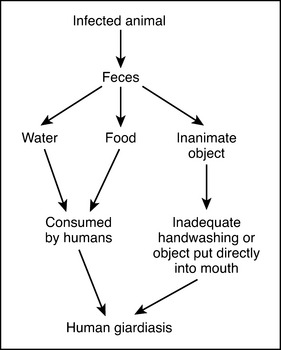GIARDIASIS (GIARDIA)
Giardiasis is the second most common cause of parasitic human diarrhea in America. The most common cause is pinworms, which are not zoonotic. Giardia is the most common cause of water-borne disease. Giardiasis is found in all regions of the United States and has been called back-packer’s disease, beaver disease, and traveler’s diarrhea.
ETIOLOGY: PARASITIC
G. intestinalis has a two-stage life cycle. In the first stage, the disease-causing trophozoite stage, G. intestinalis is found in the small intestine. In the second stage, the cyst stage, the organism is passed in the host’s feces. At this stage, it can remain viable in a moist environment for several months because of its thick protective capsule. The cysts can even withstand short-term freezing. Cysts present in the environment are swallowed when a potential host eats feces-contaminated food, drinks feces-contaminated water, or puts any feces-contaminated object in its mouth. The protective capsule is removed by the acid in the stomach, and two trophozoites are formed. The trophozoites are carried to the first part of the small intestine, where they attach to the intestinal wall and reproduce by binary fission. Some of the trophozoites will encyst and pass in the feces. Some unencysted trophozoites will also pass in the feces (Figure 17).
Stay updated, free articles. Join our Telegram channel

Full access? Get Clinical Tree



